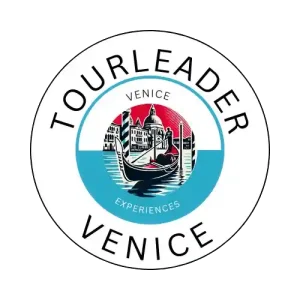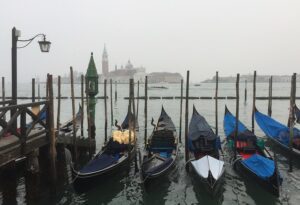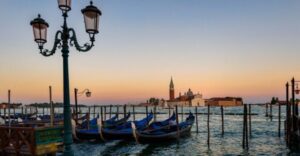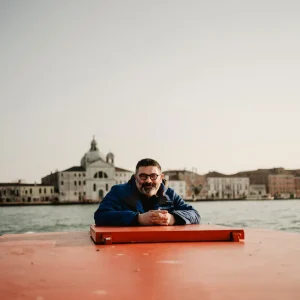The story behind the vow, the church, and the centuries-old November pilgrimage that still defines Venetian identity
Every November 21, as fog drifts over the lagoon and church bells echo across the water, thousands of Venetians walk silently toward the shining dome of Santa Maria della Salute. They carry candles, hopes, and memories — retracing a promise made nearly four hundred years ago. It’s called La Festa della Madonna della Salute, and for Venetians, it’s more than a religious holiday. It’s gratitude, memory, and survival written in light.
🏛️ How It All Began — The Plague of 1630
In the autumn of 1630, Venice was at the height of its power — rich with merchants, silk, and ships from every corner of the world. But with trade came contagion. A devastating plague, the same one immortalized by Alessandro Manzoni in I Promessi Sposi, swept through northern Italy and reached the lagoon. Within months, the city lost almost a third of its population. Entire families vanished; canals turned silent; and even the Doge’s palace fell quiet under mourning flags.
In desperation, the Doge Nicolò Contarini and the Senate made a solemn vow: if the Virgin Mary interceded to end the epidemic, Venice would build her a magnificent church — one that would forever carry her name: Santa Maria della Salute, Our Lady of Health.
By November 1631, the plague had finally receded. True to its word, the Republic began building one of the most extraordinary Baroque churches in Europe, a symbol of faith rising from despair. The architect chosen, Baldassare Longhena, was just 26 years old — but his design would become a Venetian icon.
🏗️ A Church Born from a Promise
Construction of the Basilica di Santa Maria della Salute began in 1631 and took nearly half a century to complete. Longhena envisioned a structure unlike any other in Venice: an octagonal church crowned with a great dome visible from miles away, standing at the entrance to the Grand Canal as a sign of protection for all who entered the city.
He built it on thousands of wooden piles driven deep into the lagoon’s floor — the same ancient engineering miracle that holds Venice itself. Its name, “Salute,” means “health,” but it also suggests “salvation.” Light floods its interior from every angle, symbolizing renewal after darkness. The great staircase leading up from the water was designed for pilgrims — the faithful who, every year since 1631, would climb those steps to give thanks.
Inside, the centerpiece is Titian’s moving painting, The Descent of the Holy Spirit, and above the high altar stands the miraculous icon of the Madonna della Salute — the same image the Doge once prayed to during the plague. To this day, her gaze remains serene yet unyielding, watching over the city she once saved.
🕯️ The Pilgrimage Across the Grand Canal
Every 21 November, before dawn, workers assemble a ponte votivo — a temporary floating bridge of boats stretching from Campo Santa Maria del Giglio to the Salute’s wide steps across the Grand Canal. By sunrise, the bridge is filled with Venetians walking slowly toward the church, carrying candles, whispering prayers, or simply gazing at the misty water below.
It’s not a tourist event; it’s a homecoming. Mothers push strollers, gondoliers cross in uniform, students chatter softly, and the elderly walk in silence, their faces lit by the soft glow of wax. Inside, the basilica fills with the scent of incense and the murmur of hymns that have echoed for centuries. Candles flicker under Longhena’s dome, each one a promise kept.
Outside, the air smells of roasted chestnuts and wax. Along the Fondamenta della Dogana, stalls sell castradina — smoked mutton stew — the traditional dish of the day. It’s rich, humble, and deeply Venetian, brought centuries ago by sailors returning from Dalmatia. Every household eats it during the Salute as part of the vow’s remembrance.
🍲 The Taste of Tradition — Castradina and Candles
For Venetians, no Salute is complete without castradina e verze: tender, slow-cooked mutton with cabbage and pepper, served steaming with a glass of red wine. It’s not elegant food — it’s survival food, a recipe born from plague times when supplies came only from friendly Dalmatian ports. “Xe Salute, xe castradina,” say locals — “it’s the Salute, it’s castradina.”
In pastry shops, you’ll also find frittelle, almond sweets, and chocolate coins — small gifts of celebration after the solemn walk. The mixture of faith and festivity defines this day: gratitude expressed through food, friendship, and community.
🌉 Why It’s So Deeply Venetian
Venice has many famous feasts — the Redentore in July, the Carnival in February — but none are as personal as the Salute. It isn’t about spectacle; it’s about belonging. The city that survived plague, flood, and decline still pauses once a year to say thank you. No matter how modern life becomes, on November 21 the rhythm of the city slows to candlelight pace.
Every Venetian family has a story tied to this day: a grandmother who lit a candle after an illness, a father who crossed the bridge barefoot in a promise, a child who remembers the smell of wax and fog. For many, it’s as sacred as Christmas — perhaps more, because it’s uniquely theirs.
As Francesco Guardi painted in the 18th century, the scene has barely changed: bridges, mist, devotion, and a sea of candles moving like light on water. It’s not nostalgia — it’s continuity.
🧭 Experiencing the Festa della Salute Today
If you’re visiting Venice in late November, the Salute is one of the most authentic moments you can witness. Arrive early in the morning, when locals still dominate the bridge. Bring a candle — they’re sold everywhere near the route — and cross quietly. Inside the basilica, light your candle beneath the dome, look up, and imagine the plague years that gave birth to this beauty.
After the pilgrimage, stroll through Dorsoduro, where the fog softens every corner, or stop for a bowl of castradina in a local osteria. It’s the Venice of faith, not fame — a Venice that still belongs to its people.
To understand how this celebration fits within the city’s broader rhythm, join our Explore Venice Off the Beaten Path Tour — where guides share stories of artisans, churches, and rituals that make Venice’s spirituality tangible in daily life.
And for a deeper look at the year’s full cycle of local feasts — from Carnival to Redentore — read Venetian Festivals and Rituals Through the Year.
🎟️ Visiting During the Festival
November in Venice is quiet, beautiful, and full of reflection. It’s the perfect time to explore major landmarks without crowds. If you plan to visit sacred sites like St Mark’s Basilica or the Doge’s Palace, we recommend booking Skip-the-Line Tickets in advance — leaving you more time to join the Salute procession or simply wander through the fog-covered squares.
And don’t forget to taste Venice’s November flavors: roasted chestnuts from the stalls near San Marco, a glass of Raboso wine, and of course, castradina shared among friends.
🌙 The Light That Never Fades
When night falls on November 21, the bridge is dismantled. The candles are gone, the vendors pack up, and the city exhales. Yet a faint scent of wax lingers in the air, mingling with lagoon mist. The great dome of the Salute gleams above the water, illuminated softly from within — a lantern of marble watching over the sleeping city.
Venice keeps her promises. The vow of 1630 still shines every year in candlelight, proving that devotion here isn’t a relic of the past — it’s a living part of the present. For Venetians, the Salute isn’t just a feast. It’s a heartbeat, steady as the tide.
Experience Venice Off the Beaten Path →
When is the Festa della Madonna della Salute in Venice?
The Festa della Salute takes place every year on November 21, commemorating the end of the devastating plague of 1630. In 2025, the traditional floating bridge will once again connect Campo Santa Maria del Giglio to the Basilica di Santa Maria della Salute, allowing Venetians and visitors to walk across the Grand Canal to light candles and give thanks for health and protection.
What is the meaning behind the Festa della Salute?
The celebration dates back to a vow made by the Venetian Republic in 1630 during the plague. When the city was saved, Venetians built the majestic Basilica di Santa Maria della Salute as a sign of gratitude. Each year since, locals cross the temporary bridge carrying candles to honor the Virgin Mary — a tradition that symbolizes faith, resilience, and the city’s eternal bond with the lagoon.
How can visitors experience the Festa della Salute like a local?
Arrive early on November 21 to join Venetians walking the bridge at dawn. Bring a candle to light inside the basilica beneath Longhena’s great dome, then enjoy castradina, the traditional smoked mutton stew served in homes and osterie. For deeper insight into Venice’s rituals and devotion, join our Explore Venice Off the Beaten Path Tour — where local guides share the living traditions behind the city’s most sacred celebrations.







